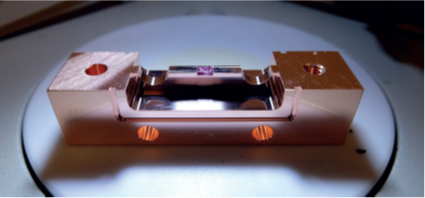Microwave Amplification by a Spin Maser (No. 0156)
|
|
<< Back to all technologies |
Summary
A novel microwave amplifier that provides high amplification gain for microwave quantum technologies.
The global quantum technology market size is projected to reach USD 31 Billion, at a CAGR of 38.4%. Much more than only computing, the quantum technology market provides a foundation for improving all digital communications, applications, content, and commerce. In the realm of communications, quantum technology will influence everything from encryption to the way that signals are passed from point A to point B. One of the crucial technological issues in quantum computing or quantum information research is low-power microwave signal processing at cryogenic (millikelvin) temperatures, i.e., the amplification of tiny microwave signals with as little added noise as possible. This low noise cryogenic amplification has been realized by a device called Josephson parametric amplifiers (JPA). However, these JPAs suffer from limited dynamic range, i.e., their very low input saturation power, which limits how many qubits can be processed in a quantum computer. Here we present a promising amplifier developed by a group of researchers led by Dr. Yuimaru Kubo which solves the above problems.
Applications
- Quantum Computer
- Ultra-Sensitive Spin Resonance Spectrometer
- Cryogenic Microwave Technology
Advantages
- High Amplification Gain (30dB)
- Large Dynamic Range (larger than -70 dBm, at least more than 1000 times better)
- Near-Quantum Limited Noise Performance (Noise temperature of ~0.5 K)
Technology
The technology is based on a system for assessing quality and performance of perovskite modules. Specifically, the system includes a chamber housing a perovskite module holder that is sealed with a window. A light source emits light that enters the chamber through the window to shine on the perovskite modules. Also included is a switch board coupled to the device holder for allowing selection of a perovskite module for measurement. A DC voltage supply is coupled to the switch board to apply voltage to the selected perovskite module. Finally, a source/measure unit (SMU) is coupled to the switch board for measuring the current of the perovskite module and I-V software analyzes the hysteresis behavior before calculating the PCE.
Media Coverage and Presentations
![]() JST Technology Showcase Presentation (JP Only)
JST Technology Showcase Presentation (JP Only)
![]() JST Technology Showcase Presentation Slides (EN)
JST Technology Showcase Presentation Slides (EN)
CONTACT FOR MORE INFORMATION
![]() Graham Garner
Graham Garner
Technology Licensing Section
![]() tls@oist.jp
tls@oist.jp
![]() +81(0)98-966-8937
+81(0)98-966-8937






